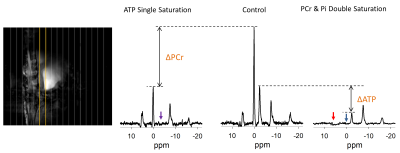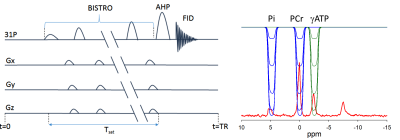Adil Bashir1, Jianyi Zhang2, and Thomas S Denney3
1Department of Electrical and Computer Engineering, Auburn University, Auburn, AL, United States, 2Biomedical Engineering, The University of Alabama at Birmingham, Birmingham, AL, United States, 3Electrical and Computer Engineering, Auburn University, Auburn, AL, United States
1Department of Electrical and Computer Engineering, Auburn University, Auburn, AL, United States, 2Biomedical Engineering, The University of Alabama at Birmingham, Birmingham, AL, United States, 3Electrical and Computer Engineering, Auburn University, Auburn, AL, United States
We demonstrate the application of indirect technique to
measure Adenosine Triphosphate (ATP) hydrolysis reaction rate constant in the in
vivo heart, without the need to quantify inorganic phosphate (Pi)
concentration. The technique was applied in human and swine hearts.

Three representative spectra from magnetization saturation transfer (MST) experiment in swine heart to measure myocardial 31P reaction rates. Control spectrum (middle) without saturation pules to measure $$$ M_{o,PCr} $$$ , and $$$ M_{o,γATP} $$$. Single resonance (γ-ATP) saturated spectrum (left) to quantify $$$ M_{s,PCr} $$$. Dual resonance(PCr and Pi) saturated spectrum (right) to quantify $$$ M_{s,γATP} $$$ .

(a) BISTRO based saturation transfer pulse sequence. Tsat is the saturation time (b) Simulationof single saturation (green) and dual saturation (blue) BISTRO RF pulse at various power levels overlaid over spectrum from heart demonstrating saturation of γ-ATP (single saturation) and PCr and Pi (dual saturation) frequencies.
